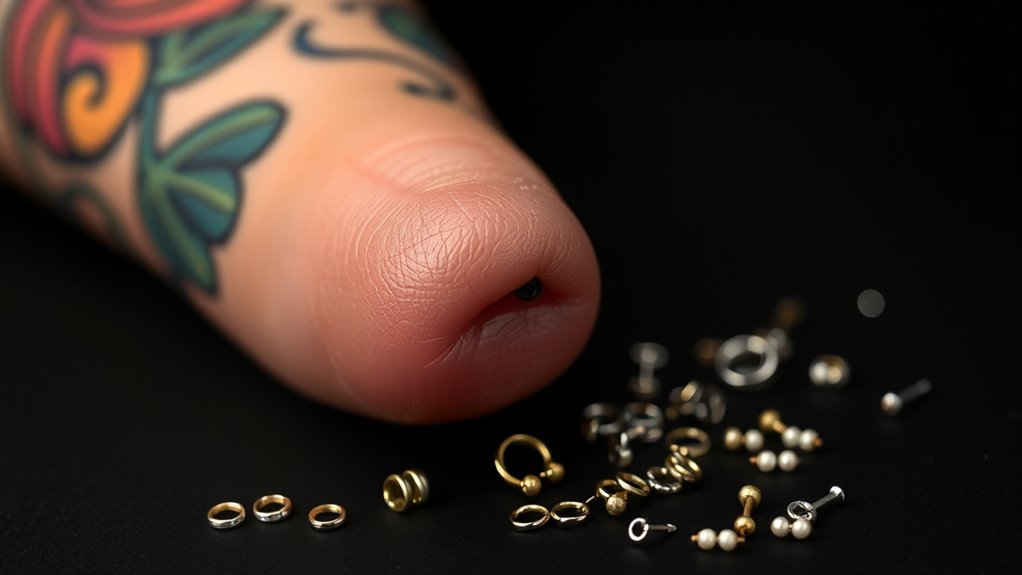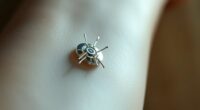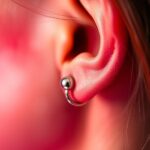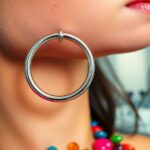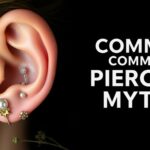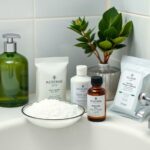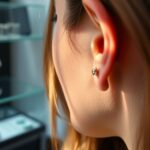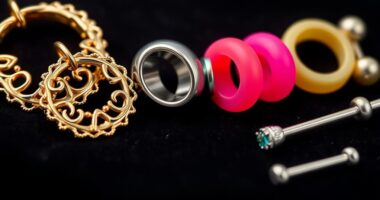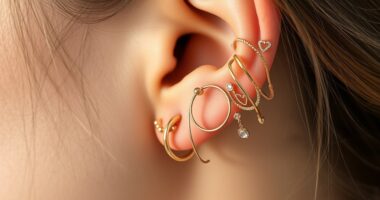Many believe that all piercings heal quickly or that they’re completely risk-free, but that’s a myth. Proper hygiene, choosing a professional studio, and following aftercare are essential for safe healing. Some think age or body type are barriers, but they aren’t. Others assume infections are rare—yet signs need prompt attention. To avoid complications and ensure a healthy experience, understanding the facts makes a big difference. Keep going to uncover the truths behind piercing myths.
Key Takeaways
- Many believe all piercings are extremely painful, but pain varies by individual and piercing location.
- Some think piercings always cause infections; proper hygiene and professional care greatly reduce this risk.
- There’s a misconception that cartilage piercings heal quickly, when they often require months to heal properly.
- Many assume all jewelry is safe for everyone, but allergies and material sensitivities can cause reactions.
- Some believe piercing is unsafe for minors, but with proper safety standards, it can be safe at any age.

Piercings often come with a mix of myths and misconceptions that can influence your decisions and expectations. One common myth is that piercing safety isn’t a serious concern, but in reality, it’s vital to choose a reputable professional who follows strict hygiene practices. Proper piercing safety isn’t just about avoiding infections; it also involves understanding the risks of complications like keloids or allergic reactions. When you decide to get pierced, make sure the studio uses sterilized tools and fresh needles. Don’t assume that all piercing parlors maintain the same standards—do your research and ask questions beforehand. This way, you reduce the chances of problems during the healing process and promote a smoother recovery.
Many believe that piercing is only safe if done at a young age, but that’s a misconception. People of all ages can safely get piercings when they follow proper guidelines. The healing process might differ depending on the location of the piercing, your age, and your overall health, but age alone isn’t a barrier. The key is to follow aftercare instructions diligently and to be aware of potential signs of infection or rejection. Ignoring these signs can prolong healing or cause permanent damage, so staying vigilant is vital.
Piercings are safe for all ages when proper aftercare and vigilance are maintained.
Another myth is that all piercings heal quickly and without issues. The truth is, the healing process varies widely depending on the type of piercing and individual factors. Ear lobes typically heal faster than cartilage piercings, which can take several months to fully recover. During the healing process, you might experience discomfort, swelling, or crusting—these are normal, but they shouldn’t be ignored if they worsen or persist. Proper cleaning routines and avoiding unnecessary trauma to the area help guarantee your piercing heals properly. Rushing to change jewelry or exposing the piercing to dirty environments can delay healing or cause infections. Additionally, choosing the right piercing studio plays a crucial role in minimizing risks and ensuring proper care.
Some people believe that piercing is completely risk-free, but that’s not accurate. Even with the best care, complications can occur, so it’s important to understand what to expect. If you notice excessive redness, pain, or pus, contact a professional promptly. Remember that healing is a delicate phase, and patience is key. The more you educate yourself about piercing safety and the healing process, the more likely you are to enjoy your new piercing without unnecessary setbacks. By staying informed and attentive, you can minimize risks and guarantee your piercing heals beautifully and safely.
Frequently Asked Questions
Can Piercing Cause Long-Term Health Issues?
Piercing can cause long-term health issues if infection risks aren’t managed properly or allergic reactions occur. You might experience persistent irritation, scarring, or allergic responses to certain metals. To minimize these risks, follow your piercer’s aftercare instructions carefully, choose hypoallergenic jewelry, and keep the piercing clean. While serious problems are rare, being vigilant helps guarantee your piercing heals well and avoids long-term complications.
Are There Age Restrictions for Getting Pierced?
Like a young sapling needing time to grow strong, your age matters when getting pierced. Typically, there are age restrictions and legal requirements to make certain of safety, often requiring parental consent for minors. These rules protect your health and well-being, much like a guardian watching over a precious bloom. Always check local regulations and consult with reputable piercers to ensure you’re following the proper legal guidelines before getting pierced.
Do All Piercings Require the Same Aftercare?
Not all piercings require the same aftercare routines, as healing time varies depending on the piercing type. You should follow specific aftercare instructions provided by your piercer to prevent infection and promote healing. For example, cartilage piercings typically need longer healing times and different cleaning methods compared to lobe piercings. Consistently caring for your piercing guarantees proper healing and reduces the risk of complications.
Is It Safe to Pierce at Home Yourself?
Piercing at home isn’t safe, much like trying to fix a watch without proper tools—DIY risks can lead to infection or injury. Unless you’re trained and have sterile equipment, home sterilization and technique fall short of professional standards. I once saw a friend attempt a nose piercing and end up with a painful infection. Trust a professional to ensure proper safety measures and sterile conditions for a safe piercing experience.
Can Piercings Be Removed Without Scarring?
Yes, piercings can be removed without significant scarring if you use proper removal techniques. The scarring potential depends on factors like your skin type and how well you care for the piercing during healing. To minimize scars, it’s best to have a professional remove the jewelry and follow their aftercare advice. Avoid trying to remove piercings yourself, as improper techniques can increase scarring and cause infection.
Conclusion
Don’t let these myths cloud your judgment like fog on a clear day. Piercing is a personal journey, and understanding the facts can help you make confident choices. Remember, proper care and expert guidance are your best allies—think of them as your trusted compass guiding you safely through the piercing adventure. Clearing up misconceptions is the key to embracing your unique style with confidence, shining brighter than any myth ever could.
Piecing together a life one day at a time, that’s me. I’m Rusty, and I love being editor-in-chief of creative piercing. It’s my passion to help others see their vision and bring it to life. When I’m not working or taking care of my family, you can find me reading a good book or eating pie (of course!).

